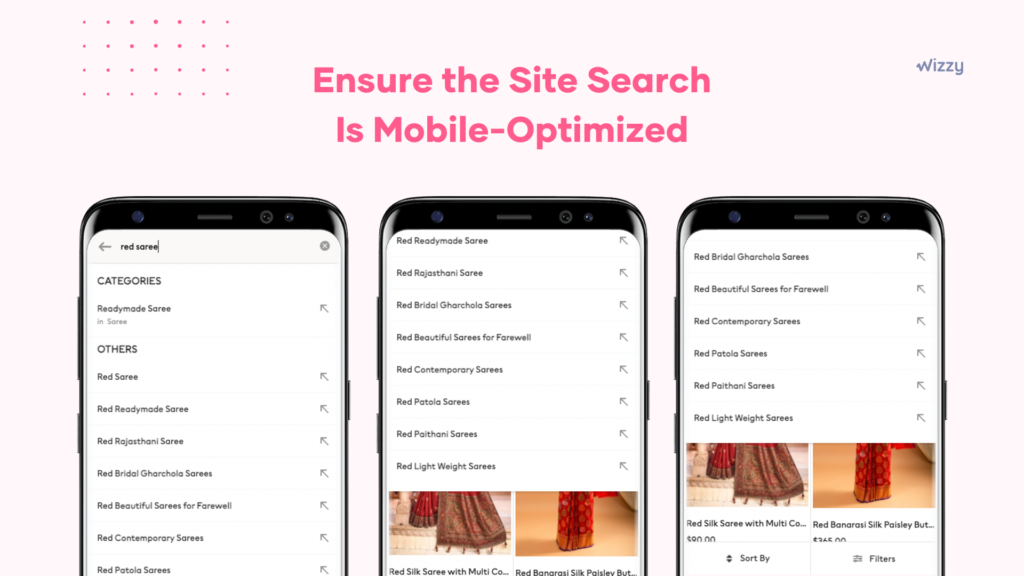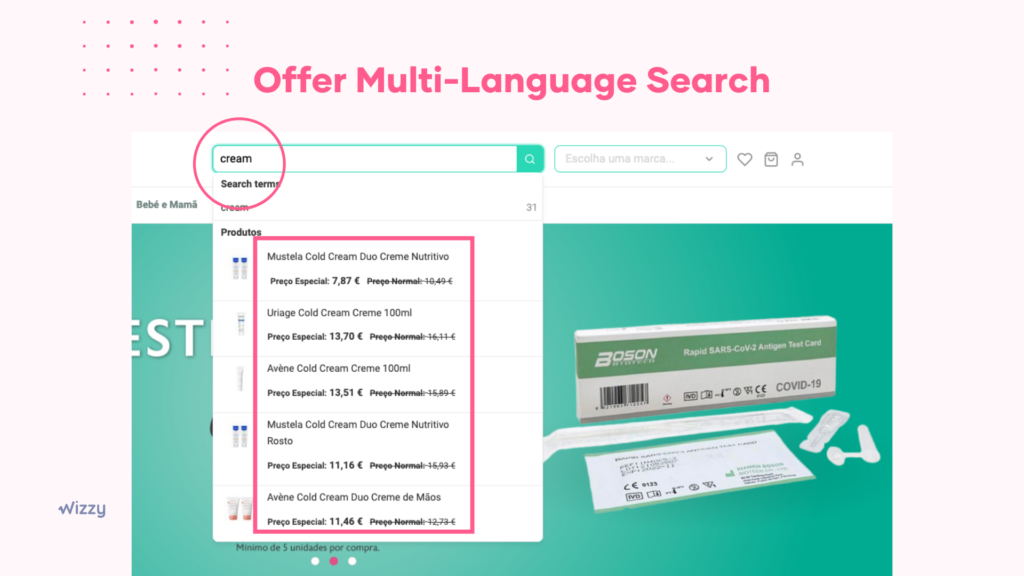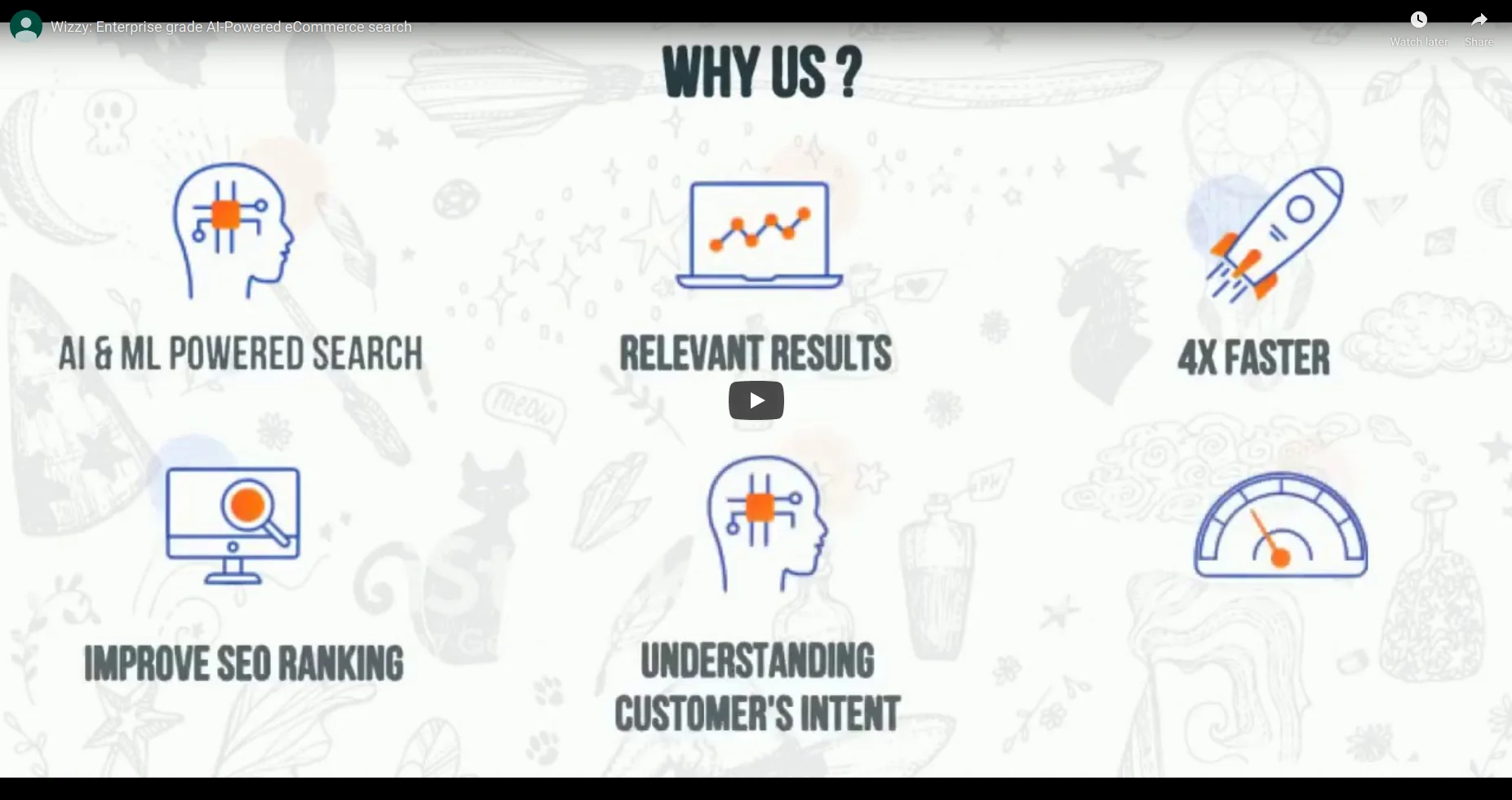Not all site searches are created equal.
Some are bloated and slow. Some are prone to returning irrelevant results. Even the most advanced site searches sometimes don’t accommodate users’ expectations, so they may not be optimized to bring in more sales.
A lot goes into a good site search engine, but here are 10 features you can add or improve to make shopping easy for your site visitors.
10 Things You Can Do to Improve Your E-Commerce Site Search
✅ 1 – Provide Implicit Search
✅ 2 – Accommodate Natural Language Search
✅ 3 – Provide Autocomplete & Spell Check
✅ 4 – Turn Your Search Visual
✅ 5 – Leverage Machine Learning To Incrementally Improve the Search Results
✅ 6 – Ensure the Site Search Is Mobile-Optimized
✅ 7 – Offer Multi-Language Search
✅ 8 – Support for Multi-Currencies
✅ 9 – Improve the Search Result Speed
✅ 10 – Include Search Filters
1. Provide Implicit Search

Implicit search refers to the ability of a site’s search engine to learn from visitor searches and provide relevant recommendations for future searches.
It understands the search’s intent even when there’s no exact keyword match. This will help users find what they are looking for even when uncertain of the product names.
In fact, 61% of US shoppers state that finding products easily in e-commerce stores is crucial for their online shopping experience.
Including implicit search on your site can provide better results even when a visitor searches with incomplete information or vague terms. For example, if a customer searches for “apple” on an electronics website, it’s hard to tell whether she wants an Apple phone or laptop, or maybe a cordless mouse shaped like an apple. The search engine needs additional context to understand what she wants.
In this case, the implicit search looks at what the customer is doing on the site right now — the page she came from, her location and shopping history — and predicts what she wants based on that information.
By providing correct results even when visitors are unsure of the spelling or phrasing of their queries, implicit search improves the user experience and streamlines your customer’s shopping process.
2. Accommodate Natural Language Search

This search feature makes it easy for your site visitors to enter a query in their own words, rather than using specific keywords or categories to find what they are looking for.
This is an excellent fit for e-commerce searches because most people do not use industry-specific terminology or product category names. Instead, they use colloquial and conversational words.
For example, suppose you ask ‘What brands of smartwatches are available under $100?’ to a salesperson at a department store. In that case, they will ask you about your needs and preferences before recommending one (or more) options.
A website search that employs natural language search would use a similar strategy to display relevant results. This makes it easier for e-commerce visitors to find what they are looking for quickly and without navigating through multiple pages.
3. Provide Autocomplete & Spell Check

Most users expect site searches to autocomplete when they enter the first few letters — and display a dropdown list of suggestions that match their input. Including this functionality helps shoppers save time by showing them real-time results as they type.
Similarly, spell check is another necessary feature that you need in your site’s search. There are times when people get confused with the product names or terms. A good spell check should identify words to grasp the shopper’s intent, even when they make spelling mistakes.
4. Turn Your Search Visual

Shoppers want to see what they’re buying before committing to buying it. So why not offer them some visual cues along with their search results?
A picture is worth a thousand words and a product image is worth a thousand sales.
It’s much easier to decide whether or not you want to buy a product based on its pictures than it is by reading its name and description. And if you’re looking for a specific product, seeing the actual item in the results makes it easier to find what you need.
So, if you have great product photographs included in site search results, you’ll be miles ahead of your competitors. Your product photography can influence people’s purchasing decisions and even impact how search engines rank your products.
5. Leverage Machine Learning To Incrementally Improve the Search Results

According to Salesforce, 75% of consumers’ site search queries are brand new each month. So, you can’t rely on manual training and optimisation to keep changing the site search functions. You require an intelligent system working in the backend to do the job for you.
The power of machine learning is that it can learn and improve every day based on search data and customer behavior. It continuously looks at what people are typing in, what they’re clicking on and what they’re buying. That makes the search results more relevant with every search, which means your customers find what they want much faster.
Let’s say that you have various hairdryers available in your e-store. But when customers keep searching for a ‘blow dryer’, your site search may fail to return with the list of hair dryers.
A machine learning algorithm can learn from the history, behavior and clicks to alter the searches and return better results.
So the next time someone searches for a ‘blow dryer’, it can return the options for hairdryers even when it’s not an exact keyword match.
6. Ensure the Site Search Is Mobile-Optimized

Mobile shoppers have greater expectations for speed and convenience, so it’s essential to make sure your site’s search function is easy for them to use.
One way to do that is to make sure your site search function works just as well on mobile as it does on desktop. Your customers should have the same experience searching for products on desktop and mobile, no matter what device they use.
There are a few ways you can make this happen:
● Make sure your search bar is easy to find.
● The search feature should be quick and easy to find on every page of your website – even if the page layout changes for mobile devices.
● Having a familiar icon or word that says “Search” next to the search bar makes it easier for users to find their way there initially.
7. Offer Multi-Language Search

Your e-commerce site search engine should offer language translation services in the countries you target if you sell internationally. It is also vital to localize the results page according to the country of each shopper.
A common way of doing this is by translating your product catalog’s entire content into the languages you want to target. This process can require a lot of time and money, but it will allow you to display products in your customer’s native tongue while catering to their specific preferences.
Another option is to have an auto-translate feature built into your site search function. This allows customers to search for products using their language and receive results based on that query.
8. Support for Multi-Currencies

Like with multiple languages, if you sell products in different currencies, you need to include currency options in your site search.
There’s nothing more frustrating than seeing a great deal on a product only to disappear because the currency is wrong or when the deal isn’t available in their region.
Multi-language sites must offer multi-currency support as well as currency conversion options. For example, a customer from Hong Kong will expect to see prices in Hong Kong dollars when they perform a search rather than U.S. dollars or euros.
9. Improve the Search Result Speed
You have probably experienced slow website searches before. Whether it’s an online store or a digital library, slow search results have probably lost you as a customer.
The speed of your website is not just dependent on how fast it loads; it also depends on the speed of your search results.
People are so short of time that they simply don’t have time to wait for a site search to load. If it’s not quick, they’ll leave and go to another online shop that can give them what they need faster.
Site search speed matters when it comes to getting customers; it could be the reason for your high bounce rate, especially in mobile shopping.
This is where site search comes into play. A good site search will return lightning-fast results —typically less than 200ms. This means that customers can quickly find what they are looking for — before they lose interest — which helps to increase your sales and revenue.
10. Include Search Filters

Adding filters to a site search can be one of the quickest ways to improve the user experience on your website.
Filters allow users to narrow their search to specific product features, thus helping them find exactly what they’re looking for.
You can use filters to help users narrow down their choices by color, size, price, model, make and other similar attributes. This will give your shoppers control over the type of product they are looking for and help them save time while browsing through multiple pages to find the desired product.
For example, if your customer searches for a ‘red shirt’ on your site, he will get a long list of results that match his query. If he wants to filter by size and price, having a filter right there with the site search would be very handy.
The more helpful information you provide in your e-commerce site search results, the easier it is for shoppers to find the right products and make purchases.
Boost Your Business Sales Through Optimized Site Search
E-commerce search engines are tricky. They’re often the first thing customers see when they enter a site and if it doesn’t work properly, you could lose them before they even get to your products.
A good search tool makes browsing and buying easy for your customers, which means more sales for you.
Wizzy has a comprehensive site search complete with natural language, machine learning, multi-lingual, multi-currency search with versatile filters. Wizzy understands your user’s intent, learns from them and displays relevant results — helping you to close deals quickly.
You can use Wizzy on any e-commerce website or app, even if it’s a custom-coded website! So try out Wizzy for your e-commerce store now and increase your sales!



